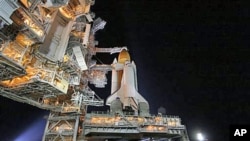As the world watches space shuttle Endeavour’s final mission to deliver equipment and science experiments to the International Space Station, a research team from Northwestern University is following the mission with special interest. It built one of the experiments - to analyze the effects of radiation and the harsh space environment on certain materials. Many scientists and researchers are worried that the end of the space shuttle program could threaten future space-based research.
Northwestern University Material Science and Engineering Professor Mark Hersam has more than just a passing interest in the final Endeavour mission. Six small pieces of his research were on board.
"These samples are thin films of carbon-based nano-materials including carbon nano-tubes and graphite," said Hersam. "These materials are being explored in our lab to offer next-generation electronic technology and also for solar cell technology."
Hersam said the samples, delivered to the International Space Station, could help advance technology used in satellites and other equipment destined for space. "We’re interested to see if they are also stable under the harsh conditions of outer space in particular the radiation they are exposed to."
Hersam said there was great uncertainty about how, when, or even if the samples would ever get into space. But several years ago, one of Hersam’s former students, now an employee of the aerospace giant, Boeing, was able to help him secure the small amount of cargo space needed to get the samples into orbit. The next step was waiting.
"We prepared the samples over 18 months ago, and we’ve been waiting, in the queue, and as the Space Shuttle [program] is coming to an end, we were actually nervous that we may never get up there. But fortunately, we made it."
Hersam knows how his experiment got into space. But with the last-ever space shuttle flight scheduled just two months from now, he’s not sure how he’s going to get the samples back to Earth.
"There still will be most likely Russian spacecraft, which will be shuttling samples back and forth, so hopefully we will be able to catch a return flight that way, but it’s not finalized yet how that will occur," said Hersam.
Professor Peter Voorhees, Hersam’s colleague at Northwestern University, said, "The challenge isn’t so much getting them up, because you have these unmanned transport vehicles that will take things up. It’s getting the samples back. So the down mass really becomes an issue."
Vorhees has successfully completed three experiments carried aboard the space shuttle. His concern is that whatever craft eventually replaces the shuttle might not be able to carry as much cargo into orbit.
"NASA, to their credit, is extraordinarily careful about what they take up and how they pack the shuttle, but it just had so much space to start with, that there was space to transport samples up and back in a reasonably timely manner," he said.
When President Barack Obama outlined his vision for the future of the U.S. space program last April, he signaled a desire to allow private companies to develop spacecraft that will fill the void left by the retiring space shuttle program. Hersam is worried that plan could push projects like his aside.
"My concern is that the motivation behind the experiments will presumably be commercial in nature, which will be a different type of research than we are doing now. I suspect that the level of discovery and serendipity will reduce if it’s being drive by bottom-line [profit] considerations. I’m worried that it’s not going to be as productive as it is now, where fundamental research can be performed," said Hersam.
Endeavour’s final mission into space is the 25th journey into orbit for the 22-year-old vehicle. It is expected to return to Earth on May 13, completing the penultimate mission of NASA’s 30 old Space Shuttle program.
Atlantis is tentatively set to make the final shuttle journey into space at the end of June.
Endeavour's Last Flight a Big Deal to University Research Team














